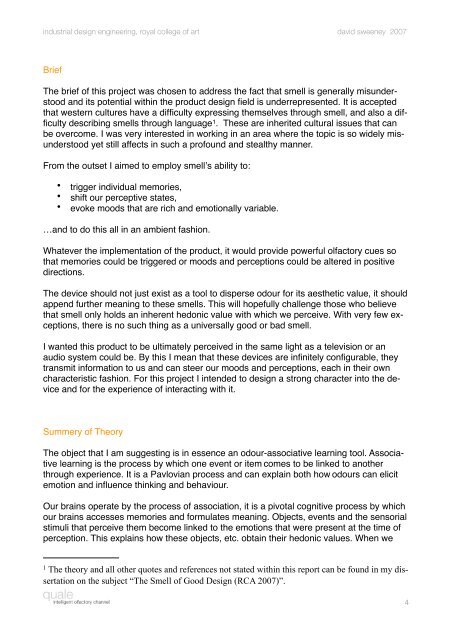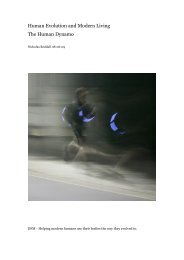industrial design engineering, royal college of art david sweeney ...
industrial design engineering, royal college of art david sweeney ...
industrial design engineering, royal college of art david sweeney ...
Create successful ePaper yourself
Turn your PDF publications into a flip-book with our unique Google optimized e-Paper software.
<strong>industrial</strong> <strong>design</strong> <strong>engineering</strong>, <strong>royal</strong> <strong>college</strong> <strong>of</strong> <strong>art</strong> <strong>david</strong> <strong>sweeney</strong> 2007<br />
Brief<br />
The brief <strong>of</strong> this project was chosen to address the fact that smell is generally misunderstood<br />
and its potential within the product <strong>design</strong> field is underrepresented. It is accepted<br />
that western cultures have a difficulty expressing themselves through smell, and also a difficulty<br />
describing smells through language 1 . These are inherited cultural issues that can<br />
be overcome. I was very interested in working in an area where the topic is so widely misunderstood<br />
yet still affects in such a pr<strong>of</strong>ound and stealthy manner.<br />
From the outset I aimed to employ smell’s ability to:<br />
• trigger individual memories,<br />
• shift our perceptive states,<br />
• evoke moods that are rich and emotionally variable.<br />
…and to do this all in an ambient fashion.<br />
Whatever the implementation <strong>of</strong> the product, it would provide powerful olfactory cues so<br />
that memories could be triggered or moods and perceptions could be altered in positive<br />
directions.<br />
The device should not just exist as a tool to disperse odour for its aesthetic value, it should<br />
append further meaning to these smells. This will hopefully challenge those who believe<br />
that smell only holds an inherent hedonic value with which we perceive. With very few exceptions,<br />
there is no such thing as a universally good or bad smell.<br />
I wanted this product to be ultimately perceived in the same light as a television or an<br />
audio system could be. By this I mean that these devices are infinitely configurable, they<br />
transmit information to us and can steer our moods and perceptions, each in their own<br />
characteristic fashion. For this project I intended to <strong>design</strong> a strong character into the device<br />
and for the experience <strong>of</strong> interacting with it.<br />
Summery <strong>of</strong> Theory<br />
The object that I am suggesting is in essence an odour-associative learning tool. Associative<br />
learning is the process by which one event or item comes to be linked to another<br />
through experience. It is a Pavlovian process and can explain both how odours can elicit<br />
emotion and influence thinking and behaviour.<br />
Our brains operate by the process <strong>of</strong> association, it is a pivotal cognitive process by which<br />
our brains accesses memories and formulates meaning. Objects, events and the sensorial<br />
stimuli that perceive them become linked to the emotions that were present at the time <strong>of</strong><br />
perception. This explains how these objects, etc. obtain their hedonic values. When we<br />
1 The theory and all other quotes and references not stated within this report can be found in my dissertation<br />
on the subject “The Smell <strong>of</strong> Good Design (RCA 2007)”.<br />
4



